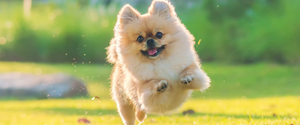
Regular exercise is one of the best ways to help your dog maintain a healthy and happy lifestyle. Plus, it’s a great way for both of you to spend time together and strengthen your bond. Every dog has different exercise needs so it’s important to keep that mind before heading out the door with your furry friend. Read on to learn how much exercise a small dog needs and to learn some small dog exercise tips.
How Much Exercise Does a Small Dog Need?
While the majority of small breed dogs can get their daily exercise through playing fetch, going on walks or playing with other dogs at the dog park, you need to take your dog’s breed and their energy levels into consideration when considering how much exercise they need.
For instance, high-energy dogs like Jack Russell terriers, need to have plenty of physical and mental exercise. In this case, introducing agility training to burn off extra energy is a great idea. If you notice your dog is exhibiting problem behaviours such as excessive barking or chewing it could be a sign of a buildup of energy, meaning your dog needs more exercise.
Walking Your Small Breed Dog
While walks are typically the best way to give your small breed dog exercise, it’s important to remember that it takes a lot of extra steps for your small dog to keep up with you. Make sure to not push your dog with overly long walks and always pay attention to his body language to make sure he’s not getting tired.
Brachycephalic breeds, or dogs with short or flat noses, can have difficulty breathing during intense exercise. Breeds like Bulldogs, Pugs, and Pekingese should avoid strenuous exercises such as jogging or swimming.
5 Tips for Exercising Your Small Breed Dog
It’s important to keep your small breed dog’s unique needs in mind before exercising. Always check in with your veterinarian before incorporating any new activities into your routine. Here are some tips on exercising your small dog:
1. Always Start Slowly
Make sure to start slowly with your small dog. If you haven’t been taking regular walks daily, it’s important to not jump into strenuous exercise immediately as your dog won’t be able to keep up with you. Start with short distances and slow speeds and gradually increase as you and your dog adapt.
2. Avoid Exercising Close to Mealtimes
It’s important to avoid walking your dog or engaging in any other intense activity around mealtimes. Choosing to exercise immediately after eating can cause dietary upsets or other serious problems for your dog.
3. Be Mindful of the Weather
Keep an eye on the weather before you decide to head out to exercise. While some dogs are okay with exercising in a little rain or snow, excessive heat or freezing conditions could pose a real hazard to your dog. Always be mindful of the temperature outdoors and consider if the conditions are safe for your dog to be in.
4. Keep it Exciting
You can keep exercise exciting and mentally stimulating for your dog by simply switching up the route you take during your daily walk so that your dog gets to see new sights and smell new smells. Alternatively, you can try a new activity such as hiking or agility training to stimulate your dog’s brain and strengthen your bond.
5. Make Sure You’re Not Overworking Your Dog
Watch out for signs of fatigue like trembling or heavy breathing. Always make sure your dog stays hydrated before, during and after exercise.
Related articles



